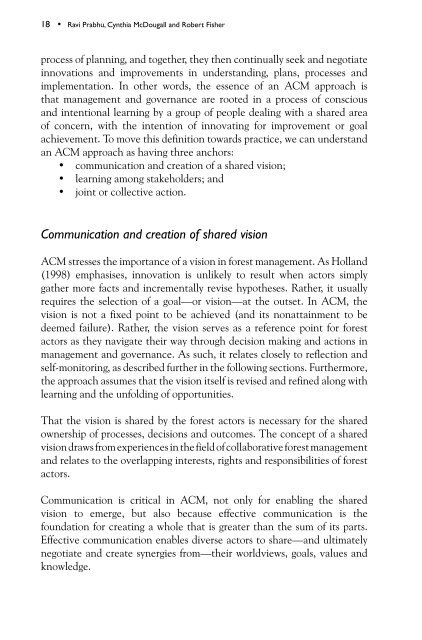Adaptive collaborative management of community forests in Asia ...
Adaptive collaborative management of community forests in Asia ...
Adaptive collaborative management of community forests in Asia ...
Create successful ePaper yourself
Turn your PDF publications into a flip-book with our unique Google optimized e-Paper software.
18 • Ravi Prabhu, Cynthia McDougall and Robert Fisher<br />
process <strong>of</strong> plann<strong>in</strong>g, and together, they then cont<strong>in</strong>ually seek and negotiate<br />
<strong>in</strong>novations and improvements <strong>in</strong> understand<strong>in</strong>g, plans, processes and<br />
implementation. In other words, the essence <strong>of</strong> an ACM approach is<br />
that <strong>management</strong> and governance are rooted <strong>in</strong> a process <strong>of</strong> conscious<br />
and <strong>in</strong>tentional learn<strong>in</strong>g by a group <strong>of</strong> people deal<strong>in</strong>g with a shared area<br />
<strong>of</strong> concern, with the <strong>in</strong>tention <strong>of</strong> <strong>in</strong>novat<strong>in</strong>g for improvement or goal<br />
achievement. To move this def<strong>in</strong>ition towards practice, we can understand<br />
an ACM approach as hav<strong>in</strong>g three anchors:<br />
• communication and creation <strong>of</strong> a shared vision;<br />
• learn<strong>in</strong>g among stakeholders; and<br />
• jo<strong>in</strong>t or collective action.<br />
Communication and creation <strong>of</strong> shared vision<br />
ACM stresses the importance <strong>of</strong> a vision <strong>in</strong> forest <strong>management</strong>. As Holland<br />
(1998) emphasises, <strong>in</strong>novation is unlikely to result when actors simply<br />
gather more facts and <strong>in</strong>crementally revise hypotheses. Rather, it usually<br />
requires the selection <strong>of</strong> a goal—or vision—at the outset. In ACM, the<br />
vision is not a fixed po<strong>in</strong>t to be achieved (and its nonatta<strong>in</strong>ment to be<br />
deemed failure). Rather, the vision serves as a reference po<strong>in</strong>t for forest<br />
actors as they navigate their way through decision mak<strong>in</strong>g and actions <strong>in</strong><br />
<strong>management</strong> and governance. As such, it relates closely to reflection and<br />
self-monitor<strong>in</strong>g, as described further <strong>in</strong> the follow<strong>in</strong>g sections. Furthermore,<br />
the approach assumes that the vision itself is revised and ref<strong>in</strong>ed along with<br />
learn<strong>in</strong>g and the unfold<strong>in</strong>g <strong>of</strong> opportunities.<br />
That the vision is shared by the forest actors is necessary for the shared<br />
ownership <strong>of</strong> processes, decisions and outcomes. The concept <strong>of</strong> a shared<br />
vision draws from experiences <strong>in</strong> the field <strong>of</strong> <strong>collaborative</strong> forest <strong>management</strong><br />
and relates to the overlapp<strong>in</strong>g <strong>in</strong>terests, rights and responsibilities <strong>of</strong> forest<br />
actors.<br />
Communication is critical <strong>in</strong> ACM, not only for enabl<strong>in</strong>g the shared<br />
vision to emerge, but also because effective communication is the<br />
foundation for creat<strong>in</strong>g a whole that is greater than the sum <strong>of</strong> its parts.<br />
Effective communication enables diverse actors to share—and ultimately<br />
negotiate and create synergies from—their worldviews, goals, values and<br />
knowledge.
















